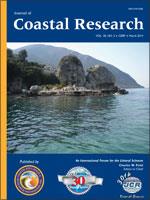Costa, D.L.; Santos, A.M.; da Silva, A.F.; Padilha, R.M.; Nogueira, V.O.; Wanderlei, E.B.; Bélanger, D.; Gomes, P.B., and Pérez, C.D., 2014. Biological impacts of the port complex of Suape on benthic reef communities (Pernambuco–Brazil).
The construction of Suape's port in 1979 divided a natural reef line into two reefs (Suape and Muro Alto) and generated changes in the hydrodynamics along the coast of Pernambuco State, Brazil. We compared the composition of the macrobenthic communities on the two reefs to determine how they were affected by the construction of the port. Two seasonal collections were made along each reef utilizing the band transect, totalizing 144 transects. Of 47 taxa found, 11 were exclusive to Suape and two to Muro Alto. The Suape reef demonstrated the greatest richness (F1,126 = 54.634, p < 0.001) and a significantly different faunal composition (analysis of similarity: r = 0.534, p < 0.001). Analyses (three-way, full factorial analysis of covariance) indicated that the reef and intertidal zone variables affected richness, whereas roughness and seasonality did not. The high intertidal zone of both reefs had greater roughness and lower richness and was significantly different from the other zones in relation to the fauna composition, confirming a two-zone intertidal zonation pattern (high and middle low). Nodilittorina ziczac and Chthamalus bisinuatus characterized the high zone of the Muro Alto, and Protopalythoa variabilis and Petaloconchus varians characterized the same zone at Suape. The construction of the port altered the tidal cycles so that the Muro Alto reef now remains exposed for longer periods, resulting in diminished richness and marked differences in its faunal composition. The original reef was 11 km long with a homogeneous community, but its division by the construction of the port resulted in several impacts to the region, principally the creation of two distinct reefs in terms of the ecological parameters analyzed, with species such as the coral Favia gravida and the zoanthid Palythoa caribaeorum disappearing from the Muro Alto reef or the gastropod Littoraria nebulosa (recorded before the construction of the port), which was not found during the present study.





